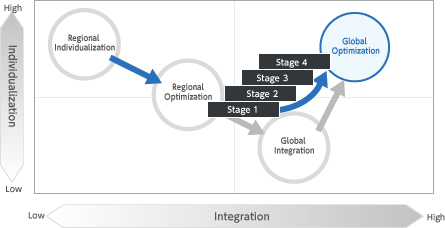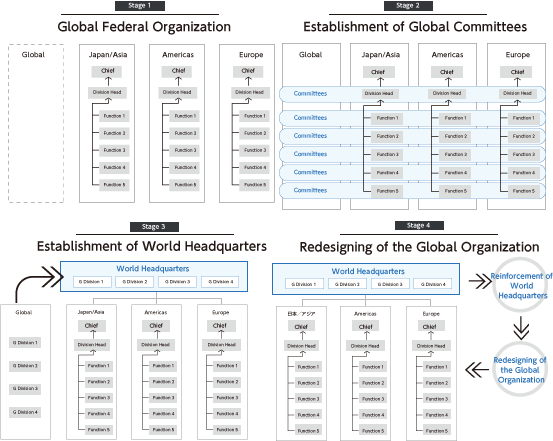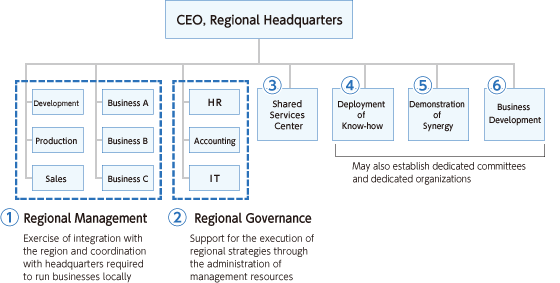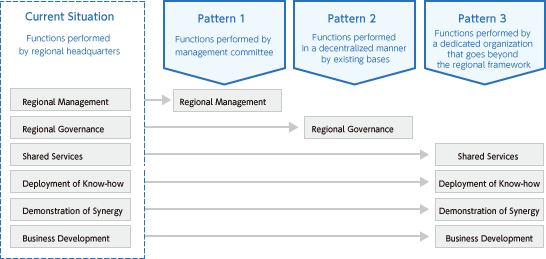This Report summarizes the discussions held with Japanese entities operating globally on the subject of regional headquarters and the insights gleaned from such discussions. Regional headquarters have contributed significantly to the global operations of Japanese entities, as links, as well as buffers, between the head office and the field. However, conventional methods based on regional headquarters will only go so far; and if Japanese entities are to prevail as global entities and seek further growth, changes must be made to the concept of the global organization itself.
Beyond RHQs
To better utilize "Beyond RHQs"
Key Messages
1) Look at the world from a bird's eye view and shore up world headquarters from the perspective of global optimization.
2) Think beyond the existing framework of regional headquarters.
3) Thoroughly consider concentration and decentralization, the unit for decentralization, and location.
1. The stages of globalization and the role of the organization
Maintaining a balance between individualization (Demonstrating respect for each country's identity and characteristics and adapting to local needs) and integration (Pursuing the economies of scale that go beyond national borders and regions, and effectively utilizing management resources) is essential in prevailing over today's world market. Japanese entities in the process of globalization are currently considered to be in the transitional stage between "regional optimization" and "global optimization".

An organization's transition from "regional optimization" to "global optimization" may be broken down into four stages:
| Stage 1 | The regional organizations are mutually independent and there is minimum coordination between the regions. |
|---|---|
| Stage 2 | Various global committees are set up in order to deal with the increasing need for global consultation |
| Stage 3 | As globalization progresses committees can no longer adequately deal with rising global needs and it becomes necessary to set up world headquarters |
| Stage 4 | World headquarters, in the true sense of the word, capable of determining the global allocation of resources and optimization are established and the global organization is redesigned. |
It should be noted that only world headquarters are capable of taking a bird's eye view of the world and determining global optimization, and that the reinforcement, there of, is indispensable toward the realization of global optimization.
< Organizational Structure >
Artwork from "Regional Best" to the "Global Best"

2. Are there functions integral to regional headquarters?
Regional headquarters have played a crucial role for Japanese entities, which have pursued global expansion to date without the presence of world headquarters. Nevertheless, it will become necessary to transform the very concept of regional headquarters, while shoring up world headquarters, if the Japanese entities are to achieve global optimization.
What, then, are the aspects of regional headquarters that should be changed? Chapter 2 of the Report will discuss in detail the current situation and issues, and the necessary initiatives by focusing on the six major functions of regional headquarters;



The Report will be cover main points but, suffice it to say, that the organization executing the six functions does not necessarily have to be regional headquarters. In fact, in order to resolve the issues surrounding the six functions, it is preferable that we think beyond the existing framework of regional headquarters and pursue the optimal method of executing these functions.

3. Key points to consider when redesigning the global organization
Although the global organization will need to be redesigned by world headquarters in Stage 4, there will be no universal solution. Chapter 3 will discuss the guidelines to be followed in considering a new global organization.
There are three points to be considered when redesigning the global organization:
1) Which functions require concentrated efforts and
which functions should be performed in a decentralized manner;
2) If the execution of a function is to be decentralized,
then what will be the smallest unit for performing the function; and
3) The location of the base.
Here, the term "function" may be replaced by "capability." What is important is that the entities first realize the core capabilities required to win on the world market and subsequently envision the organization that would reinforce their core capabilities.
Obviously the global control centre functions of taking a bird's eye view of the world and determining global optimization need to be performed in a concentrated manner. However, as far as the other functions are concerned, whether such functions should be performed in a concentrated or a decentralized manner will depend on certain prerequisites (e.g. standardization). Consequently, it is preferable that the entity deliberately determines which functions require concentrated efforts and which functions require decentralized efforts, and then creates the conditions that will enable the performance of such functions.
When functions are to be decentralized, the smallest unit for its performance will not necessarily be the "region" overseen by the regional headquarters. For example, units based on markets will not necessarily be geographically adjacent but may expand beyond the framework of a particular "region." Typical examples are the markets of the emerging countries. If an entity were to adopt the unit of the "Americas" and "EMEA," the Americas would include the emerging countries of South America and EMEA would include the emerging countries of the Middle East / Africa (and in some cases, Russia). In order for an entity to reinforce its approach to the emerging markets, it may be necessary to adopt a separate unit for the emerging markets.
The four points to be considered when selecting a location are:
1. Ease of doing business,
2. Business costs,
3. Access to superior human resources;
4. Access to critical markets.
While the points to be emphasized will vary according to the function, the important thing is to determine the location for conducting the functions that would provide the greatest competitive edge.
Careful exploration of the above three points will provide the entity with a clear vision of the global organization to which it should aspire. As stated earlier, there is no universal solution. However, if we were to take the liberty of projecting our image of this organization, it would be "consolidated hubs", where a hub that executes its functions globally and in a concentrated manner and a hub that conducts its functions in a decentralized manner through various units have been connected by networks.
This summarizes the points made in Chapter 4.
Summary
Rapid growth of the emerging countries has made the world markets increasingly multipolar, which, in turn, has made many Japanese corporations shore up their regional headquarters.
Regional headquarters have been adopted as effective solutions to the various issues caused by the traditional, homeland-centric management model, namely shortage of management resources, limits of governance, inefficient business operations, slow decision-making, and a lack of understanding about local markets.
Regional headquarters have six major functions: 1) Regional management, 2) regional governance, 3) shared services, 4) know-how transfer, 5) synergy realization, and 6) business development.
Regional management refers to the exercise of integration and coordination to operate businesses within the region. Regional governance supports the execution of regional strategies through the administration of management resources (people, goods, money and information). Shared services refer to the consolidation of back-office operations within the region and the provision thereof as shared services. Know-how transfer drives the global deployment of the know-how accumulated by the head office as well as the sharing of the local know-how both within the region and across the regions. Synergy realization encourages companies with multiple business divisions to unleash synergy between the various businesses within the region. And business development means promoting alliances with and M&As of promising business partners within the region.
In today's world market two conflicting forces, namely individualization and integration, are at work. Individualization is required in order to respect each country's identity and characteristics, and adapt to local needs. Meanwhile, integration is required in order to pursue the economies of scale that go beyond national borders and regions, and effectively utilize management resources.
Regional headquarters to date have accommodated tensions between integration and individualization on a regional level in accordance with the governance dictated by the head office (regional optimization). However, in order to compete successfully in today's world market, managing tensions between integration and individualization on a global level, not a regional level, has become essential (global optimization).
Not surprisingly, the key factor for success is evolving from regional optimization to global optimization; with the regional headquarters required to change and adapt. In terms of the six major functions, regional management will require integration and coordination from a global perspective; regional governance will need to promote regional standardization; shared services will need to maximize the economies of scale; know-how transfer will need to promote the sharing of local know-how across the regions; synergy realization will require the involvement of the business divisions and the management of the PDCA cycle; and business development will need to accumulate organizational capabilities and build an organization capable of making rapid decisions and taking quick actions.
Note that companies do not necessarily need to think inside the box of regional headquarters to solve these issues pertaining to the six functions. Select the best alternative whether it is the execution of functions by a management committee at a regional level, the decentralized execution of functions by existing local entities, or the execution of functions by a specialist organization that goes beyond regional borders.
Therefore, as far as functions are concerned, it is no longer necessary to establish regional headquarters in order to execute functions required by each region.
There are three points which need to be considered to achieve global optimization. First of all, we must decide which functions should be centralized and which functions should be decentralized. Secondly, if the execution of a function is to be decentralized, then the optimum unit for performing the function must be determined. And thirdly, we will need to decide where the base of performing functions should be located. The criteria for deciding these factors should be what would be best for leveraging the company's strengths and winning in the world market.
Obviously the global control tower functions (strategy formulation and resource allocation) need to be performed in a concentrated manner. However, whether other functions should be performed in a concentrated or a decentralized manner depends on certain prerequisites (e.g. standardization of knowledge and processes) and thus a careful evaluation of these prerequisites needs to be made.
When functions are to be decentralized, the optimum unit for its performance may differ from the "region" (subcontinent) overseen by the regional headquarters. For example, markets may not be geographically adjacent but may expand beyond a particular "region." Additionally, common languages and time zones are crucial to operations and units based on these factors may not necessarily coincide with the "region."
The location of the base should provide the greatest competitive edge when carrying out the functions. In specific terms, factors such as the ease of doing business, business costs, access to talents and access to priority markets need to be weighed.
The next generation global organization that lies beyond regional headquarters can only be envisioned after your company carefully explores the above three points (concentration and decentralization, the unit for decentralization, and location). If we were to take the liberty to project our vision of this framework, it would be a "connected-hub-based organization" where global hubs, which execute functions globally and in a concentrated manner, and decentralized hubs, which carry out functions in a decentralized manner through various units, are highly networked. In such a framework, the "region" (subcontinent) under the traditional regional headquarters would merely become one out of a variety of units.
In order to win in the world market, global optimization must be realized. And in order to realize global optimization, the functions of regional headquarters must first be unbundled and transformed into a "connected-hub-based organization." This is the message that we would like to underline in our report.
单击此处咨询
